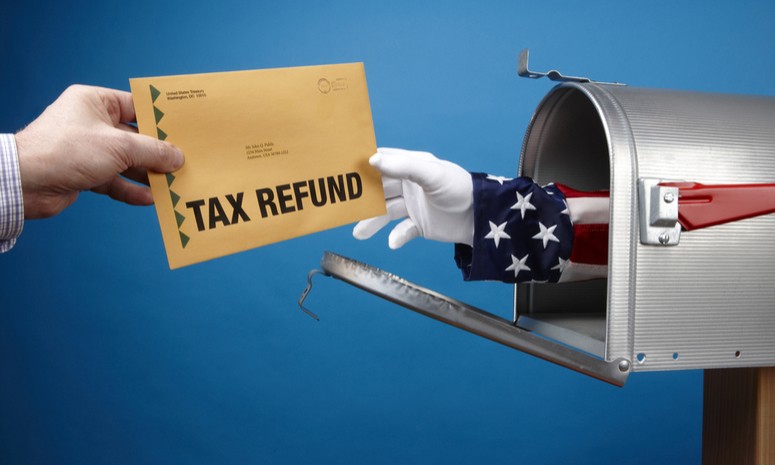Don’t spend it all at once.
Eagerly awaiting your tax refund? Before you start an online shopping spree or earmark the money for something really big, like an 85-inch TV, stop and think for a moment. These are economically challenging times. Yes, you deserve to treat yourself, but this may be the time to do something boring and practical with your money. You may thank yourself later. That said, we do have some fun ideas that follow as well. The main thing, as they say, is to think about where you want your money to go – and don’t spend it all at once.
Start an emergency fund.
Your tires could all go flat. Your refrigerator could die. You could wind up paying for hefty hospital bills due to the coronavirus. You never know what you might be able to use extra money for, and so you can never go wrong with using your tax refund for an emergency fund.
“Aim to have one year’s worth of living expenses set aside in cash. For example, money market accounts, savings accounts, CDs,” says Pam Krueger, CEO and founder of Wealthramp.com, a financial referral service for people looking for fiduciary advisors. Krueger recommends looking for online banks that are FDIC-insured since those tend to offer the highest yields.
Pay off debt.
It may not be the most fun thing to do with a tax refund, but your future self will thank you. “Start by making bigger payments to the most expensive credit cards you have that have the highest interest rates,” Krueger advises. “The best way to make 12% on your money totally risk-free is to not pay it out in annual interest expenses. Put it back in your pocket.”
That’s assuming you’re lucky enough to have a credit card with 12% interest. Plenty of credit cards offer 20% or more in interest. So if you are carrying revolving debt, sinking your tax refund into it could pay off for you big time.
Shore up your savings.
You have an emergency fund, but hopefully you’re also putting money into a savings account for anything extra – emergencies, vacations, retirement, a cushion to keep you from going into overdraft and so on.
Interest rates average .06 annual percentage yield for savings accounts these days, according to data from the FDIC. But you can find savings accounts and CDs that are above the national interest rate average, and if you find some that are 1% or a bit higher, consider that a win. Really, the main thing is that you’re in the habit of putting money away.
Save for an upcoming expense.
“Similar to building an emergency fund, the idea behind this concept is to choose a goal and a dollar amount to save for that goal and then build monthly savings into your budget to fund it. This is often referred to as a savings fund,” says Drew Feutz, a financial planner with Market Street Wealth Management Advisors in Indianapolis.
In other words, instead of saving for something you aren’t planning for (an emergency), use your tax refund to save for something you are planning for: summer camp for your child next year or holiday gifts, for example.
Feutz says that you may want to have multiple savings funds. “Some banks allow you to create ‘sub-accounts’ so that the money all remains within one account, but you can see which goal each dollar is earmarked for,” Feutz says.
Fund home improvements.
If you own a house, it’s probably your most valuable asset, and you want to keep it that way. Besides, you might find that spending money now on your home saves you more in the long run; if something isn’t fixed, like water damage, the repairs will probably get more expensive. So if you want a new roof, your tax refund could literally put a roof over your head. Or maybe with all the time you’ve been spending at home, it’s time to build that deck you’ve always wanted.
And if you don’t have a house, but you’ve always wanted one? Your tax refund could go toward an eventual down payment.
Donate to charity.
If you feel like you’re doing pretty well, you could always give your tax refund, or some of it, to charity. CharityNavigator.org is an excellent website to research some of the nonprofits and good causes that are out there.
In any case, charities right now can use all the help they can get. In April, Charity Navigator surveyed 298 nonprofits and found that 83% of them were suffering financially – at a time, of course, when many of these nonprofits are needed more than ever.
Boost your retirement fund.
You can never go wrong using your tax refund to recharge your retirement fund. “Get the power of compound interest working for you. The earlier you start, the more your savings will snowball into real wealth,” Krueger says.
In fact, she maintains that one fat tax refund could really pay off if you invested it in your retirement fund.
“An average refund is $3,200,” Krueger says. “An additional $1,200 a year invested in the stock market that grows 6 percent a year can become $60,000 more in your nest egg in 25 years.”
Seed a 529 plan.
Do you have kids? Have you been putting money away for their college education? That would be a good place to put a tax refund, says Ryan Decker, director of the Center for Financial Literacy at North Central College in Naperville, Illinois. He is also an assistant professor of economics and finance.
And being responsible is never a bad idea with a tax refund. As Decker says, “Remember, your tax refund is money you overpaid the federal government. It is money that you could have kept in your paycheck throughout the year. Don’t treat it as a bonus – treat it as regular income.”
So if you intended to put more money in your kids’ college account, this is a perfectly reasonable place for your tax refund to go.
Save for vacation.
If you aren’t going on a vacation this year, and plenty of Americans aren’t, it wouldn’t be a bad idea to put your money toward a trip you’re planning to take. It’s hard to find a consensus on exactly how much the average American vacation costs these days, but a lot of sources suggest around $1,000 – per family member.
Whatever you spend, it probably feels like a crazy amount.
So if summer vacations often tax you financially, well, this year’s tax refund may be what you need to be fully prepared for next year to have an amazing vacation without draining your bank account.












